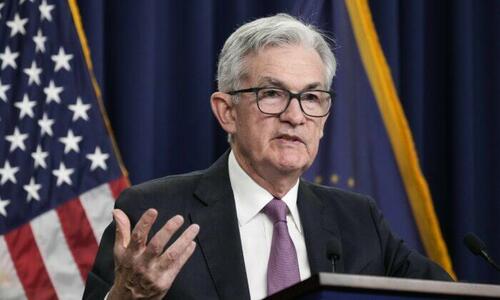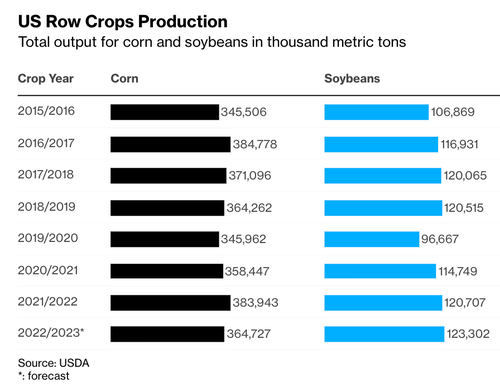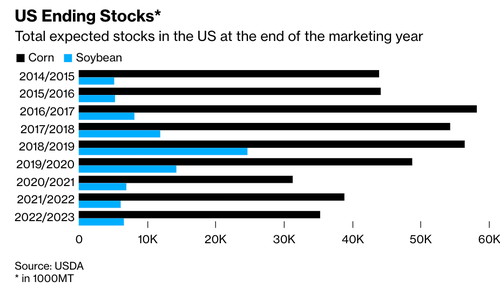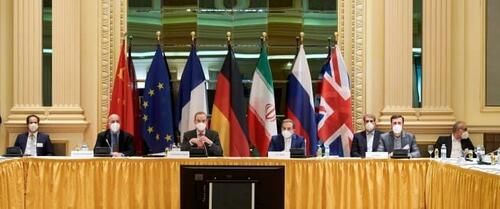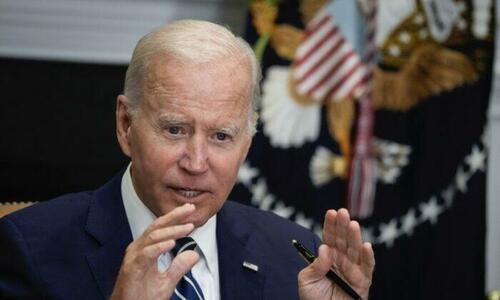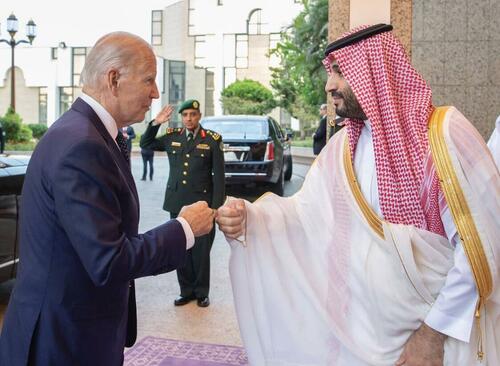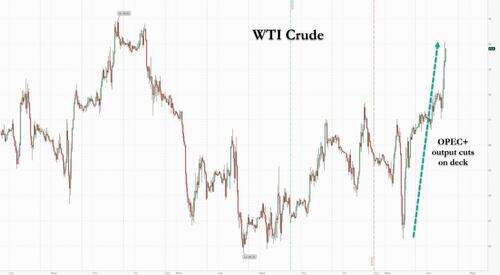Powell’s “Put”: Out Of Money & Time
Authored by Michael Pento via PentoPort.com,
Despite all the fanfare and cheerleading you hear in the MSFM, the recent bounce in equity prices has just been a rather pedestrian bear market rally. Bull markets are not engendered by a faltering global economy, very high rates of inflation, and the most hawkish global central bank tightening cycle in history.
In spite of these dynamics, stock prices have now completely priced in a perfectly soft landing for the U.S. economy. How else would you characterize trading at 17.5 times 2023 S&P 500 ebullient earnings estimate of $245, according to FactSet. Keep in mind the $6 trillion of helicopter money ended in 2021 and earnings growth for Q2 2022 is negative 4 percent, excluding the energy sector. However, Wall Street is still projecting an increase of 50 percent for 2023 EPS from the pre-COVID level.
Nevertheless, the consumer still faces a barrage of negative shocks: A reverse wealth effect from falling equity and bond prices. The virtual complete shutdown of cash-out refinancing and the lower mortgage payments that come with it, which are down over 80 percent year over year. Anemic GDP and earnings growth. Falling real incomes. And in addition to all this, we still have to deal with aggressive fed rate hikes and a double-dosed pace of Quantitative Tightening (QT).
Wall Street is trying to convince you that peak inflation will lead to a ‘Powell Pivot’ towards dovishness. A dovish fed is one that is cutting rates back to zero percent and engaging in QE. But, peak inflation, which will still be 3-4 times higher than the target rate, should only cause the fed to reduce its hiking pace to 50 basis-point increments from 75 bps. In this age of redefining the meaning of recessions and bear markets, a dovish central banker is now being defined as one that wants to raise rates by “only” 50bp increments.
Meanwhile $95 billion of base money supply will get destroyed each month starting in September. This will happen in the context of a falling stock market, housing prices rolling over, and a potential spike in the unemployment rate. And, for those who still have a job, real incomes that continue to fall.
Lower bond yields and peaking inflation were a green light for higher stock prices in July. But that ebullience over an improving inflation rate should soon just become another signal of faltering economic growth.
Real Estate Prices to Follow Stock Prices Lower
The National Association of Realtors’ housing-affordability index, which factors in home prices, mortgage rates, and family income, fell to 98.5 in June. That is the lowest level of affordability in the past 33 years.
Mortgage costs are up 54 percent y/y in June. And the median existing-home price is $423,000 this June. It was just $94,000 33 years ago. But what else would you expect when you have unelected money printing maniacs in control of the money supply? In other words, a house that does nothing but decay closer back to the dirt over the years has gained 350 percent in value. That rate of appreciation has been many times greater than incomes over the decades.
A home is offered for sale in Chicago, Ill., on April 26, 2022. (Scott Olson/Getty Images)
The real estate market is dysfunctional and posing systemic risk once again. At 40 percent of core CPI, home price appreciation must be put back into a tractable situation for inflation to be tamed and that will require a hawkish Fed for many months to come.
Evidence of a Faltering Economy
The U.S. August Homebuilder Index fell to 49, which is in now contraction territory—the estimate from economists was for a reading of 54. Housing starts fell by 9.6 percent and single-family home construction dropped by 18.5 percent year over year.
We Have Seen This Movie Before
The last time the Fed hiked the Fed Funds Rates above 2.25 percent was Sept. 27, 2018. It was also doing just $45 billion per month of QT at the same time. That caused the S&P 500 to lose 20 percent and the Russell 2000 to lose 28 percent of their respective values by the end of year. During this timeframe, GDP growth was 3 percent. The carnage in markets was so sharp that Fed Chair Powell had to promise to stop hiking rates by the end of December. But then again, he could afford to pivot easily back then because CPI was just 1.9 percent.
Today, much like the fall of 2018, the Effective Fed Funds Rate is 2.3 percent and is heading towards 3.3 percent by year’s end. But unlike the strong economy seen in 2018, GDP growth was negative in the first half of this year and is projected to be just 1.6 percent in Q3, according to the Atlanta Fed.
Also, the pace of QT is more than double the rate it was back in 2018. In addition, the stock market is more expensive today and with more leverage in the economy than at any other time in history prior to the start of this year. And as for that much anticipated Powell Pivot, 8.5 percent consumer price inflation is a much bigger hurdle to overcome than any other time in the past 40 years. Powell’s equity “Put” is way out of the money and far out in time.
Therefore, rather than getting caught up in chasing the FOMO rally, it is much smarter and beneficial to your financial health to get positioned for what is happening next: a global recession, which pushes money into U.S. sovereign debt and the U.S. dollar; and out of equities. That is, at least until Powell has the cover to perform an actually pivot back to QE and ZIRP, which will then start to cause the dollar to tank and stagflation to run intractable.
Twenty dollar bills are counted in North Andover, Mass., in a file photo dated June 15, 2018. (Elise Amendola/AP Photo)
Some perma-bulls liken today’s market to that of 1982. This was also a time when inflation had peaked. Back then, Fed Chair Paul Volcker was cutting rates from 15 percent in March of ’82, to 8.5 percent by year’s end. The only salient similarity between 1982 and today is that inflation has peaked.
However, the Fed is not cutting rates at this juncture. As stated, Powell is only slowing the pace of rate hikes from 75 bps to 50bps. And unlike 40 years ago, the Fed is also engaged in the most destructive pace of money destruction in history—more than a trillion dollars per year for the next 2-2.5 years. Most importantly, the PE ratio of the S&P 500 was just 7.7 back in 1982—not the overvalued 21.5 PE ratio we see today. Also, the total market cap of stocks as a percentage of the underlying economy was just 34 percent 40 years ago, not the frothy 170 percent we witness now. And, there is no Ronald Reagan in office cutting taxes and reducing regulations.
There is no time in history that compares with today’s record-high inflation and overvalued stock, fixed income, and real estate markets.
This dysfunctional and deformed market is prone to 30 percent, or even 50percent+ plunges—as it has done in the past and is even more likely to do so in the future. Avoiding such a massacre in your retirement plans is a really good idea. Hence, successfully navigating these inflation/deflation cycles is the smartest way to invest.
Tyler Durden
Tue, 08/23/2022 – 12:26
via ZeroHedge News https://ift.tt/rBnoOe5 Tyler Durden
